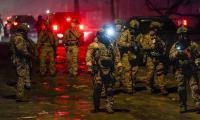Sindh’s politicians believe census launched without adequate publicity
Pakistan’s population and housing censuses have always been marred with controversies and blame games by political parties consistently claiming that their electorates have been undercounted.
Census is a decennial activity. This time round, however, the country is witnessing its seventh census after only six years because almost all the political parties, especially in Sindh, had rejected the results of the 2017 population count.
Attempting to ensure the accuracy of the results of the latest census, the Pakistan Bureau of Statistics (PBS), which is mandated to conduct the population count under the General Statistics (Reorganisation) Act, 2011, is for the first time holding the activity digitally.
This census will prove crucial in redrawing the country’s political map, all the while the nation grapples with an unprecedented economic crisis. However, Sindh’s political parties have a myriad concerns with the population count this time as well.
Lack of publicity
Sindh Chief Minister Syed Murad Ali Shah of the Pakistan Peoples Party (PPP) has written to Federal Minister for Planning, Development & Special Initiatives Ahsan Iqbal of the Pakistan Muslim League-Nawaz about the province’s census-related issues.
The CM laments insufficient publicity of the population count through the print, electronic and social media. “Consequently, the outcome of the awareness and information dissemination campaign has fallen short of the desired results. A clear evidence of that is the abysmal number of household registrations in the self-enumeration phase.”
The Muttahida Qaumi Movement-Pakistan’s Senior Deputy Convener Dr Farooq Sattar mentioned the same reservation in his letter to Chief Census Commissioner Dr Naeem Uz Zafar. He termed the publicity and awareness campaign for the population count inadequate.
The Field Operation Plan (FOP) of the PBS lists a number of functions for censuses. The first is about policy, planning, coordination, publicity and administration of the population count. One of the main recommendations and terms of reference formulated by the census advisory committee comprising demographers and other experts is about publicity of the population count.
The committee stresses on communication, advocacy and publicity of the census through print, electronic and social media campaigns from the start to the end with a localised approach.
It is the function of the provincial, regional and field officers of the PBS to arrange publicity of the census at provincial and district levels for eliciting public cooperation in the activity.
Pilot census
The PBS held a pilot census last year from July 20 to August 3 in 33 selected administrative districts all over Pakistan, including Azad Jammu & Kashmir and Gilgit-Baltistan. The FOP mentions nothing about the results of the pilot census, and only its methodology and process, and the issues faced by the enumerators.
The CM claimed in his letter that the provincial government was kept in the dark about the pilot census results. He said the information of its first phase, the housing census, was also in silos. “This will create problems for the local administration in monitoring, reporting progress and taking immediate actions to address issues.”
Regarding the political parties’ concerns, Zafar told The News that the provincial administration, from the commissioner to the assistant commissioner, has access to the progress of the enumeration, even the house count.
When asked why the live data is not shared on the PBS website, he said the progress of the enumeration is not uniform in every area, so there are data syncing issues at a few places, affecting the census reporting and giving room to speculations.
He explained that while the enumeration is in process, people start noting the numbers and extrapolating them, but if later their extrapolation turns out wrong, they blame the PBS for undercounting.
He said the PBS wants to find out the actual count of the population rather than fulfilling someone’s extrapolation based on the live data being shared on the website.
Floods
The CM said that 2.1 million homes were damaged in the recent floods in Sindh, with 1.4 million of them destroyed and the families living in them displaced.
“It is not yet known how the demolished homes will be counted, marked and geo-tagged,” he said, adding that in some districts, seasonal migration of a considerable population takes place, so arrangements are needed for a proper household count during such internal migrations.
Talking to The News, Qaumi Awami Tehreek Sindh President Ayaz Latif Palijo also shared his concerns about the population count, pointing out the massive internal migration in the province due to the floods.
Zafar responded that the PBS has a set parameter of counting people in the area they are living in, explaining that people will be counted in an area where they have been living or intend to live for at least six months.
He pointed out that in the census form, there is a module of migration that has a specific question asking if the person has migrated because of the 2022 floods. He explained that the migrator will also have to mention which district they have migrated to and from.
As for the flood affected houses, he said, the houses that exist in any form will be geo-tagged, but there will not be a population count if people are not living there. Houses that have been swept away in the floods cannot be counted or geo-tagged, he added.
Block discrepancy
According to the FOP, the country has been divided into 185,509 small blocks for the population and house count. Sindh has 43,838 blocks, each of which has 200 to 250 houses. The CM has voiced concerns on the forming of blocks and the inconsistencies in the maps provided to the enumerators in contrast to the on-ground situation. “Reportedly, many blocks are not based on compact population.”
Sattar points out in his letter that Karachi has been divided into 16,000 blocks, which is a far lower number. He explained that as per the 2017 census report, the total number of blocks in Karachi Division were 14,552.
He said that if the number of houses in one block is to be taken as 250, the total number of houses in the city would be 14,552 times 250, which equals 3,638,000 houses.
As per the PBS standard, he added, on average there are six persons in a house in Karachi, so 3,638,000 times six brings the headcount to 21,828,000.
He recalled that in 2014, PPP Senator Taj Haider citing NADRA had declared Karachi’s population to be 21,347,871, which had to date not been denied by anyone, including the PBS.
He also said that there was a higher probability of flats and apartments in a building not being counted as separate housing entities just like it had happened in the previous census.
Palijo pointed out that for the 43,838 blocks in Sindh there are only 28,908 enumerators, so each enumerator would have to cover at least one and a half blocks.
He said that in the rural areas a single village has 30 to 40 houses, so the enumerator would have to count 10 villages for completing a block. “Every village is half an hour to 45 minutes away from the next one,” he explained, pointing out that this is not humanly possible.
Zafar responded that if a census block has more houses, they will have to deploy extra workforce. He said that before the census they had updated most of the blocks as per the total house count, but they could not do all of it.
It would not affect the enumeration process, though, because whether it is 50 houses or 500 houses, the PBS would count a block, he added.
CNIC issue
Palijo voiced concerns about counting the population without the condition of showing the CNIC. “Do they want to count illegal immigrants? Do they want to change the demography of Sindh?”
Zafar replied that in the 2017 census a few political parties had issues with the mandatory condition of showing the CNIC. He said that before the current census was started, all the provinces had demanded the CNIC condition, so they implemented it.
However, he pointed out, if someone does not have a CNIC, they would still be counted. For example, he explained, if a Burmese or a Bengali in Karachi does not have a CNIC, he would be counted as an alien.
-
 Philippines Blocks Elon Musk’s Grok AI
Philippines Blocks Elon Musk’s Grok AI -
 Jennifer Lawrence Blames Internet For Losing Sharon Tate Role
Jennifer Lawrence Blames Internet For Losing Sharon Tate Role -
 DeepMind, Google CEOs Sync Daily To Accelerate AI Race Against OpenAI
DeepMind, Google CEOs Sync Daily To Accelerate AI Race Against OpenAI -
 Japan Launches Probe Into 'Grok AI' Following Global Scrutiny Over 'inappropriate' Content
Japan Launches Probe Into 'Grok AI' Following Global Scrutiny Over 'inappropriate' Content -
 Prince Harry All Set To Return To Britain Next Week?
Prince Harry All Set To Return To Britain Next Week? -
 Is Princess Charlotte Becoming Most Confident Young Royal?
Is Princess Charlotte Becoming Most Confident Young Royal? -
 ‘Stranger Things’ Star David Harbour Speaks Up About ‘psychotherapy’
‘Stranger Things’ Star David Harbour Speaks Up About ‘psychotherapy’ -
 Jennifer Love Hewitt Talks About Scary 9-1-1 Episode
Jennifer Love Hewitt Talks About Scary 9-1-1 Episode -
 Kate Middleton Ditches Palace Life For Where She 'truly Relaxes'
Kate Middleton Ditches Palace Life For Where She 'truly Relaxes' -
 Pixel Watch May Soon Warn You If You Leave It Behind
Pixel Watch May Soon Warn You If You Leave It Behind -
 Serious Liver Scarring Shows Potential To Be Reversed With Latest Drug
Serious Liver Scarring Shows Potential To Be Reversed With Latest Drug -
 Elon Musk Backs Donald Trump To Invoke Insurrection Act Amid Minnesota Protests
Elon Musk Backs Donald Trump To Invoke Insurrection Act Amid Minnesota Protests -
 Scientists Unravel Mystery Of James Webb’s ‘little Red Dots’ In Deep Space
Scientists Unravel Mystery Of James Webb’s ‘little Red Dots’ In Deep Space -
 Nano Banana Explained: How Google’s AI Got Its Name
Nano Banana Explained: How Google’s AI Got Its Name -
 Fire Causes Power Outage On Tokyo Train Lines, Thousands Stranded As ‘operations Halted’
Fire Causes Power Outage On Tokyo Train Lines, Thousands Stranded As ‘operations Halted’ -
 YouTube, BBC To Ink Landmark Deal To Launch Exclusive Bespoke Shows
YouTube, BBC To Ink Landmark Deal To Launch Exclusive Bespoke Shows



